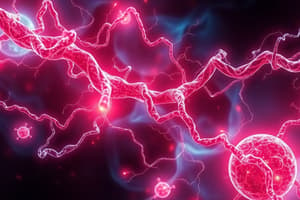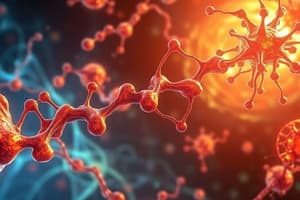Podcast
Questions and Answers
What is the main purpose of anabolic pathways in metabolism?
What is the main purpose of anabolic pathways in metabolism?
- To construct larger molecules using energy from catabolic pathways (correct)
- To eliminate metabolic waste products
- To break down molecules and release energy
- To convert the energy in food into energy available to run cellular processes
Which of the following is the process of making glycogen, a storage form of glucose?
Which of the following is the process of making glycogen, a storage form of glucose?
- Glycogenolysis
- Glycogenesis (correct)
- Glycosis
- Lipogenesis
What is the first step in the process of lipogenesis, the synthesis of triglycerides?
What is the first step in the process of lipogenesis, the synthesis of triglycerides?
- The breakdown of glucose to generate ATP through glycolysis
- The release of energy through catabolic pathways
- The conversion of glycogen polymer into glycogen
- The formation of malonyl-CoA from acetyl-CoA and CO2 (correct)
Which of the following processes is the reverse of glycogenesis?
Which of the following processes is the reverse of glycogenesis?
Which of the following is a part of the anabolic process of cellular respiration?
Which of the following is a part of the anabolic process of cellular respiration?
What is the role of glycogen synthase in the process of glycogenesis?
What is the role of glycogen synthase in the process of glycogenesis?
Study Notes
Metabolism and Anabolic Pathways
Metabolism is the set of life-sustaining chemical reactions in organisms that convert the energy in food into energy available to run cellular processes, produce building blocks for proteins, lipids, nucleic acids, and some carbohydrates, and eliminate metabolic waste products. It is essential for maintaining life and involves two main types of pathways: catabolic and anabolic. Catabolic pathways break down molecules to release energy, while anabolic pathways construct larger molecules using energy from catabolic pathways. Let's dive deeper into the anabolic pathways, specifically those involved in storing excess energy and synthesizing triglycerides.
Glycogenesis and Glycosis
Glycogenesis is the process of making glycogen, a large polysaccharide molecule that serves as a storage form of glucose. During this process, UDP-glucose is added to the growing glycogen chain by glycogen synthase, which converts glycogen polymer into glycogen. Glycogenolysis, the reverse process, breaks down glycogen into glucose for immediate use by cells.
Glycosis, or cellular respiration, occurs in the cytoplasm and involves breaking down glucose to generate ATP. This process includes several stages, including glycolysis, pyruvate oxidation, and the citric acid cycle.
Lipogenesis
Lipogenesis is the synthesis of triglycerides and is part of anabolic metabolism. It begins with the formation of malonyl-CoA from acetyl-CoA and CO2. From there, fatty acid synthase adds two-carbon units to the growing fatty acid chain, resulting in palmitoyl-CoA. Palmitoyl-CoA is then converted to oleoyl-CoA by desaturases before undergoing further elongation, if necessary. Fatty acids are then attached to glycerol to form phosphatidic acid, which is then converted to other forms of lipids such as triacylglycerols, cholesterol esters, and sterol esters.
In summary, anabolic pathways play a crucial role in building new tissue, such as muscle, and synthesizing energy-storage molecules like glycogen and triglycerides. These processes are often regulated by factors such as energy status, hormones, and substrate and end-product levels to maintain cellular efficiency.
Studying That Suits You
Use AI to generate personalized quizzes and flashcards to suit your learning preferences.
Description
Explore the essential anabolic pathways involved in storing excess energy and synthesizing triglycerides in metabolism. Learn about glycogenesis, glycosis (cellular respiration), and lipogenesis, and understand how these processes contribute to building new tissue and energy storage in organisms.




